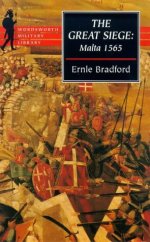
The Great Siege: Malta 1565
Ernle Bradford
256 pages, including notes and index
published in 1961
I originally bought this book because I wanted to know more about the great siege of Malta after reading Dorothy Dunnett's Disorderly Knights, which is partially set during it. After buying it, I promptly forgot about it until I saw it again recently while shifting a pile of books.
In 1522 the Order of St. John, one of the three military orders created by the Catholic Church during the Crusades was kicked out of their island home of Rhodes by Soleyman the Magnificant, the Ottoman Emperor. The knights of St. John spent the next eight years making the rounds of the various Christian kings to plead for a new home, before Emperor Charles V gifted them Malta. A rocky, sparsely populated and desolate island, it was nothing like their previous home.
From a strategic point of view, it was however highly superior, though it took some time for the Knights realised it. If you look at a map of the Mediterranean Sea, Malta is right in the middle of it, dominating the traderoutes from the Eatern to the Western Mediterranean. From Malta, the Knights of St. John could and did raid Ottoman convoys, not to mention attack its possessions or that of its allies in Northern Africa. It is therefore no surprise that Soleyman took the decision in 1564 to conquer Malta, ending the threat of the Order as well as gaining a valuable jumping off points for further conquests in the Eastern Mediterranean.
To do this, Soleyman assembled quite a large army; even conservative sources put it at at least 30,000 men, plus support. His ablest commanders would lead this army and it was well provided with everything needed for the siege and conquest of Malta. Against them stood some 700 Knights, plus a further 8,000 to 9,000 regular fighting men. The defences of the island, though much improved through the efforts of Grand Master La Valette, the Order's leader, were in part still weak and certainly not expected to hold out long against a determined opponent. Yet the Knights managed to hold out for three months and see off the Turks. How could this happen?
Partially this is due to the leadership and command skills of La Valette, who recognised early that the only way to survive was a defence in depth: no fort would be surrendered, each in turn had to and did fight to the death. Partially it was also the fighting spirits of the knights and their men,a s they stubbornly held out against odds others would've given up on long before. Then there was the divided leadership of the Turkish army, which at strategic points led to the Turks doing exactly the wrong thing. Partially it was luck, as when the most feared of the Turkish leaders and the only one who could unite army and fleet, the Corsair Dragut was killed early in the siege. All these factors helped the Knights to survive a siege nobody had expected they would live through.
This, as you may expect would make a very exciting adventure story and this is more or less how Ernle Bradford treats the Siege. The Great Siege is better described as the story of the siege of Malta, than as the history of it. This is not a bad thing and Ernle Bradford is objective enough to recognise both the flaws of the Knights and the virtues of the Ottomans, even if the former clearly emerge as the heroes of this history. Since most histories form some form of narriteve, if only because they put a chronological order on things, I didn't mind this at all; rather enjoyed it, in fact.
